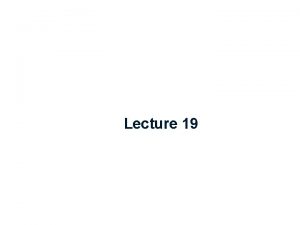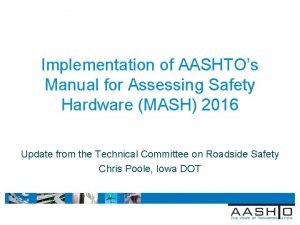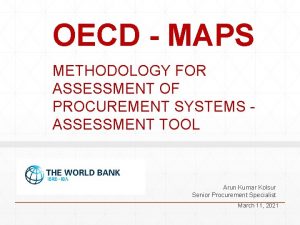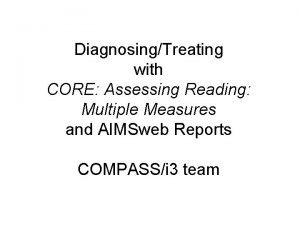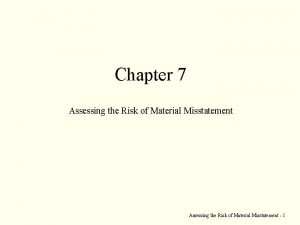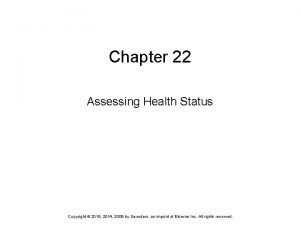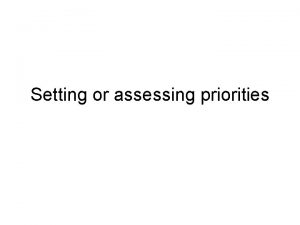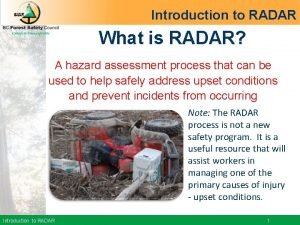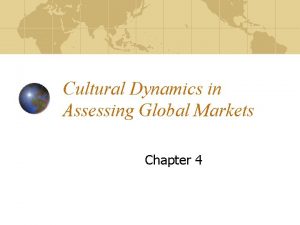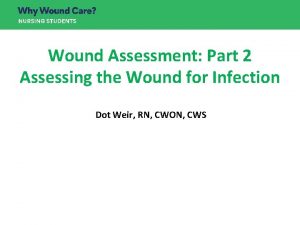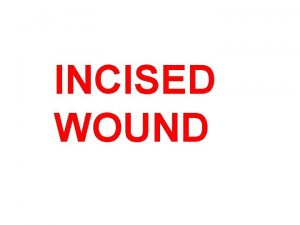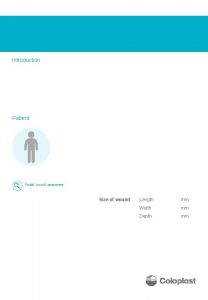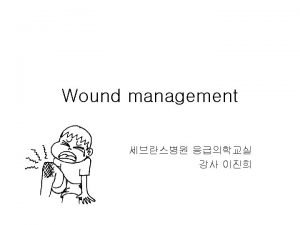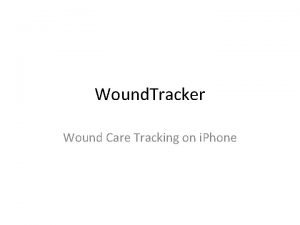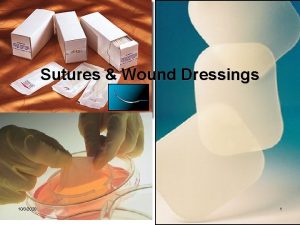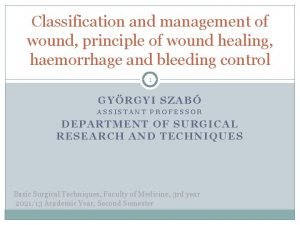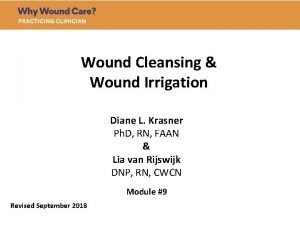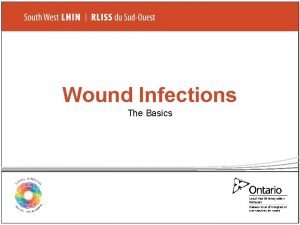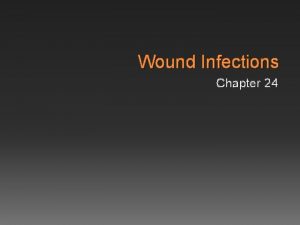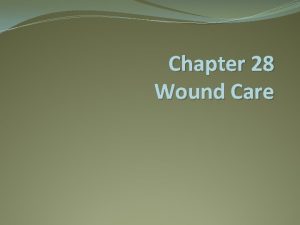Wound Assessment Part 2 Assessing the Wound for






































- Slides: 38

Wound Assessment: Part 2 Assessing the Wound for Infection Dot Weir, RN, CWON, CWS

Objectives 1. Discuss the spectrum of bioburden in open wounds. 2. Describe the evolution of a biofilm 3. Name the steps in obtaining a meaningful wound culture

The Skin as Protection • Provides mechanical barrier to the invasion of bacteria and other pathogens into the deeper tissues • Skin oils, lipids and sweat help prevent invasion of bacteria into tissue • The skin surface is a relatively acidic environment (p. H 4 -6. 6), not supportive of bacterial growth • Skin cells shed into the environment keeping the bacteria at a tolerable level Stotts NA. Bioburden Infection, In: Baranoski S, Ayello EA. Wound Care Essentials, Practice Principles, 4 th edition, 2016 Lippincott Williams & Wilkins, Philadelphia

Defining Bioburden • Degree of microbial contamination or microbial load; the number of microorganisms contaminating an object 1 - Assumed to be quantified relative to the object • In wound management and wound healing, often a statement to the presence of bacteria on a wound as well as a qualitative descriptor of the bacterial status of the wound • As a result, it has also become a term used to document and consequently rationalize and support the use of various treatment alternatives - Specifically dressings and devices known to impact surface wound bacteria, such as antiseptics, antimicrobial dressings, and modalities such as ultrasound 1. Stedman’s Medical Dictionary

Describing Bacteria • Bacteria are described in a number of ways • • Shape Gram Stain Need, or lack of need, for oxygen Mode of growth

Shape • Great variation but 3 basic shapes Coccus: round or ball shaped Rod or bacillus: cylindrical Spirillum or spirochete: spiral shaped cylinder

Gram Stain • Staining technique for the early identification of bacteria Gram-positive cells have thick walls which will uptake crystal violet Gram-negative cells have thinner walls, do not hold violet dye, and retain counter-stained red color

Aerobic vs. Anaerobic • Do they require oxygen to survive? O 2 vs. O 2 © Dot Weir - Used with permission

Microbial States in Wounds • Contamination • • Colonization • • Presence of replicating organizations in the wound; no host immune response Critical Colonization/ Locally Infected • • Presence of non-replicating organizations in the wound; no host immune response Replicating organizations competing for resources, begin to see changes in the wound; biofilm forming; host tissue reaction Infection • Presence of replicating organizations in the wound with a host immune response © Dot Weir - Used with permission

What Does This Look Like? Sterile Infected Contaminated Colonized Critically Colonized

Critical Colonization • Presence of bacteria on the wound • Healing process compromised • No standard signs of infection • May delay healing via bacterial competition with tissue cells for oxygen and nutrients, production of bacterial toxins and inflammatory mediators • Also referred to as “locally infected” (vs. spreading infection)

Potential Signs of Critical Colonization • Granulation tissue • Color • Friability • Absent or abnormal • Odor – subtle or dramatic change • Failure to heal • Increased/high exudate levels in the presence of granulation tissue • Wounds attempt to “flush out” foreign particles or chemicals

Bacterial Growth • Planktonic: free floating, individual cells that work independently • Wound cultures are testing for planktonic growth • Most topical antimicrobial agents target planktonic growth • Antibiotics are developed to target specific sites to kill them • Easily transferred from one surface to another • Skin to wound • Contamination from outside source

Biofilms • Complex communities of bacteria (and other organisms) that adhere to solid surfaces (e. g. catheters) • Embedded in an extracellular polymeric substance • Have ability to survive in hostile environments • Contain different structures including channels in which circulation of nutrients can occur • Possess unique ability to communicate • Reduced metabolic activity leading to reduced metabolic needs • Systemic and most topical antibacterial/ antimicrobial agents cannot impact or kill

Predisposing Conditions that Contribute to Infections… • Damage of stratum corneum allowing for bacterial penetration • High concentration of bacteria • Immunocompromised host • Type of bacteria • Disruption of blood supply to the area • A favorable environment for bacteria • Moisture • oxygen/lack ©of oxygen • necrotic debris

Infection: Definition Invasion by and multiplication of pathogenic microorganisms in a bodily part or tissue, which may produce subsequent tissue injury and progress to overt disease through a variety of cellular or toxic mechanisms. http: //medical-dictionary. thefreedictionary. com/infection © Accessed 3/17/13

Infection: Clinical Picture • • • Swelling Induration Erythema Warmth Pain Odor

Assessment of Bacterial Burden © Dot Weir - Used with permission

Diagnosis • Diagnosing infection is a clinical skill and not a microbiologic technique • Culturing doesn’t tell you whether you have an infection or not; it identifies the organism and appropriate antibiotic • The culture is important but also need to focus on the host (the patient) and the wound environment

Method of Wound Culture • Biopsy • Aspiration • Swab © Dot Weir - Used with permission

Quantitative Tissue Biopsy • Historically the “gold standard” or at least best practice • Painful (may need anesthetic) • Skill intensive © Dot • Used more in research than clinical practice • >105 colony forming units (CFU) per gram of tissue considered to be infected © Dot Weir - Used with permission

Aspiration • Goal: obtain fluid for specimen below the surface of the wound • Skin is prepped (alcohol) • Needle inserted, fluid aspirated • Apply to swab

Improve Swab Technique • Thoroughly rinse wound surface with nonpreserved saline/cleaner • • Don’t swab through dressing residue, old exudate, necrotic tissue, blood Choose area that is free of non-viable tissue if possible Don’t bother with dry surfaces Place in carrier, transport ASAP

Methods of Swab Culture • Z Stroke • Levine’s Technique © Dot Weir - Used with permission • Goal is to get sampling of organisms on or in surface tissues of the wound • Necrotic tissue harbors large numbers of bacteria so should be avoided

Methods of Swab Culture • Z Stroke • • Less optimal Likely to pick up organism from necrotic tissue if present, skin edges © Dot Weir - Used with permission

Levine’s Technique • Surface swab of a one cm 2 area of healthy tissue in the wound • Press into wound to obtain fluid 1 cm area

Levine’s Technique

Location, Location… © Dot Weir - Used with permission • • Aim for clean area of the wound Avoid touching necrotic tissue © Dot Weir - Used with permission

Culture Reporting • Need to have the most information available to make sound decisions for treatment • Know the hospital/labs method of reporting cultures • • Gram Staining: automatically done or need to order separately? Qualitative Semi-quantitative Quantitative © Dot Weir - Used with permission

Culture Reporting • Gram Staining • • Provides early information as to the bacterial species likely to be present on the wound (not 100%) Also may indicate host response • Presence of white blood cells © Dot Weir - Used with permission

Culture Reporting • Qualitative Cultures: Presence of bacteria and antibiotic activities only © Dot Weir - Used with permission

Culture Reporting • Semi-quantitative cultures: Dish divided into 4 quadrants, serially streaked, and the number of quadrants with growth is reported © Dot Weir - Used with permission 1+ 2+ 4+ 3+ © Dot Weir - Used with permission

Culture Reporting • Quantitative cultures: provides actual colony forming units per gram of tissue of the bacteria identified in the wound. Usually needs tissue biopsy to determine. © Dot Weir - Used with permission

Key Nursing Concepts Ø Ø Ø Ø Assessment Caring Communication Ethics Evidence-based practice Infection Control Pain Patient Education Prevention Self Care Deficit Safety Tissue Integrity

Key Nursing Diagnoses Ø Potential for Alteration in Skin Integrity Ø Potential for Alteration in Tissue Integrity Ø Impaired Skin Integrity Ø Impaired Tissue Integrity Ø Oral Mucous Membranes, Altered Ø Knowledge Deficit r/t Ø Self Care Deficit r/t

Key Nursing Practice Issues • Registered Nurses (RN) assess wounds; Licensed Practice Nurses monitor wounds per state nurse practice acts • Accurate wound assessment and documentation is foundation for evaluating attainment of progress towards goal of care • Early recognition of a change in the bacterial load on an open wound is critical to prevent deeper infection • When culturing needed, attention to detail and getting a meaningful, usable culture is essential

Websites for Further Information on Wounds - Association for the Advancement of Wound Care www. aawc 1. org - Canadian Association for Wound Care www. cawc. net - National Pressure Ulcer Advisory Panel www. npuap. org - World Union of Wound Healing Societies www. wuwhs. org - Wound Ostomy Continence Nurses Society www. wocn. org

www. Why. Wound. Care. com
 Assessing risk in sport
Assessing risk in sport Unit 18 assessing children's development support needs
Unit 18 assessing children's development support needs Ways to address grammar in the writing classroom
Ways to address grammar in the writing classroom Ppst curriculum and planning
Ppst curriculum and planning Assessing need for hrd
Assessing need for hrd Disadvantages of informal reading inventories
Disadvantages of informal reading inventories Manual for assessing safety hardware
Manual for assessing safety hardware Chapter 4 cultural dynamics in assessing global markets
Chapter 4 cultural dynamics in assessing global markets Assessing a new venture's financial strength and viability
Assessing a new venture's financial strength and viability Assessing cardiorespiratory fitness
Assessing cardiorespiratory fitness Assessing leadership and measuring its effects
Assessing leadership and measuring its effects Module 4 topic 1 assessing and managing risk
Module 4 topic 1 assessing and managing risk Module 4 topic 1 assessing and managing risk
Module 4 topic 1 assessing and managing risk A nine box matrix requires assessing employees on ________.
A nine box matrix requires assessing employees on ________. Oecd maps
Oecd maps Core assessing reading multiple measures
Core assessing reading multiple measures Audit risk model
Audit risk model Assessing math concepts
Assessing math concepts Assessing health status chapter 22
Assessing health status chapter 22 Assessing motivation to change
Assessing motivation to change Assessing opportunity cost involves
Assessing opportunity cost involves Assessing the situation
Assessing the situation Cultural dynamics in assessing global markets
Cultural dynamics in assessing global markets Assessing value for money
Assessing value for money Parental capacity example
Parental capacity example Group discussion vs debate
Group discussion vs debate The globe framework for assessing cultures
The globe framework for assessing cultures Cultural dynamics in assessing global markets
Cultural dynamics in assessing global markets Assessing the internal environment of the firm
Assessing the internal environment of the firm Assessing hrd needs
Assessing hrd needs Fspos
Fspos Typiska novell drag
Typiska novell drag Nationell inriktning för artificiell intelligens
Nationell inriktning för artificiell intelligens Vad står k.r.å.k.a.n för
Vad står k.r.å.k.a.n för Varför kallas perioden 1918-1939 för mellankrigstiden
Varför kallas perioden 1918-1939 för mellankrigstiden En lathund för arbete med kontinuitetshantering
En lathund för arbete med kontinuitetshantering Särskild löneskatt för pensionskostnader
Särskild löneskatt för pensionskostnader Tidböcker
Tidböcker Sura för anatom
Sura för anatom




